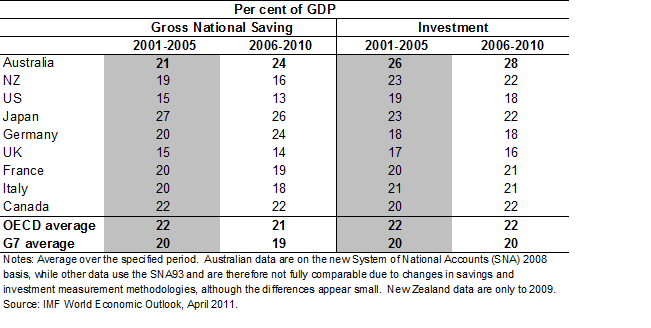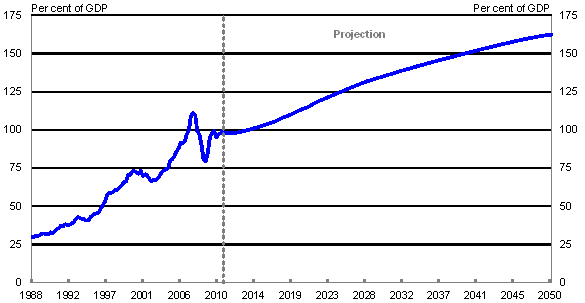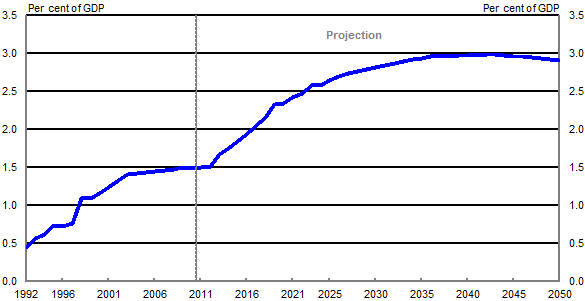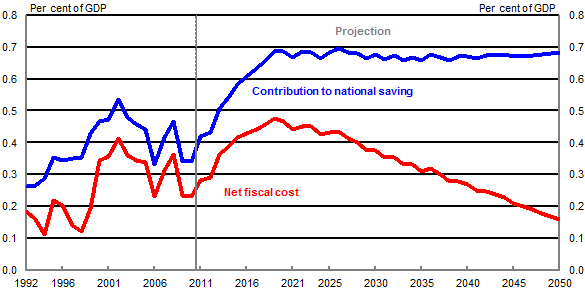Downloads
Introduction
Thank you for the opportunity to speak to you.
The question of whether, as a nation, Australia saves enough has been a recurring one – especially in the years since the mid 1980s as it became increasingly clear that sizeable current account deficits were becoming a prominent feature of the Australian economic landscape.2
Most recently, this question has again been brought to the fore by the mining boom, with its huge boost to Australian national income. In its most recent incarnation, many have argued that Australia needs a sovereign wealth fund to save more of the bounty from the mining boom for the benefit of future generations.
In my remarks today, I want to make a modest contribution to this debate. In particular, I want to discuss the role that compulsory superannuation has played, and will continue to play, in contributing to Australia's national saving.
Australian national saving and investment
Before delving into the details of compulsory super, it is of interest to recall how Australia fares, relative to peer countries, in terms of gross national saving and investment. Table 1 shows the results for Australia, New Zealand, and the G7 countries, for the decade to 2010, with outcomes shown separately for the first and second halves of the decade.
Table 1: Gross National Saving and Investment

In the first half of the decade, Australia's gross national saving rate was close to the average for both the G7 and the OECD while, in the second half of the decade, Australia's saving rate was clearly above the average rates for the G7 and the OECD.
Of course, this second period is punctuated by the global financial crisis, and therefore might not be a good guide to longer term trends. Nevertheless, Australia's gross national saving rate in the 2000s is clearly similar to or, in many cases, higher than the saving rates of comparable countries.
Of particular note is the comparison with the other Anglophone countries (Canada, New Zealand, United States and United Kingdom) which have similar deregulated financial systems, which facilitate peoples' capacity to borrow against assets and future income, and thereby tend to reduce national saving rates.3 Compared to these other Anglophone countries, Australia's national saving rate stands out as being high.
As Table 1 also makes clear, Australia's persistently high current account deficits are a consequence of very high national investment, rather than low saving. Over the decade to 2010, Australia's national investment rate has been well above those of all the other countries in Table 1, averaging a full 5 percentage points of GDP above the OECD average over that time.
One important contributor to Australia's relatively high national saving rate is the long history of prudent fiscal policy in Australia that has kept net government debt at low levels and thereby contributed to national saving.4
Another important contributor to Australia's high national saving has been the establishment and gradual growth in compulsory superannuation.
It is to this that I now turn.
The history of compulsory super
The compulsory superannuation system began with industrial award-based superannuation, agreed by the Government of the day and the Australian Council of Trade Unions as part of the 1985 Prices and Incomes Accord. A 3 per cent superannuation contribution was paid by employers into employees' individual accounts in nominated superannuation funds, rather than being paid as a wage rise.5
The coverage of award superannuation was expanded significantly in 1992, with the introduction of the Superannuation Guarantee Levy, which required employers to make superannuation contributions on behalf of their employees, and enshrined superannuation contributions in federal legislation rather than relying on the award system.
The then Government announced plans to gradually increase the minimum contribution rate to 9 per cent by 2000/01 (amended by the subsequent government to 2002/03). In 2010, the current Government announced plans to raise the contribution rate gradually from 9 per cent to reach 12 per cent by 2019-20.
The expansion of the superannuation system saw employee coverage rise sharply, from around 40 per cent of total public and private sector employees in the mid 1980s, to more than 90 per cent a decade later, where it has broadly stabilised. This growth in coverage of superannuation and the gradual rise in contribution rates have seen a strong rise in superannuation assets, so that they now constitute the second largest component of household wealth after property assets (owner-occupied housing and other property assets).6
At the end of 2010, total superannuation assets, arising from both compulsory and voluntary super contributions, were around $1.3 trillion, or about 100 per cent of annual GDP (Figure 1). With the proposed increase in the Superannuation Guarantee to 12 per cent, total superannuation assets are projected to grow to over 160 per cent of GDP by mid century, assuming a 4 per cent real pre-tax after-fee rate of return on assets, which is the average over the past 30 years.
Figure 1: Superannuation assets

Source: ABS Catalogue Numbers 5206.0, 5232.0, APRA and Treasury.
As I will discuss in more detail shortly, the stock of assets in the Australian superannuation system is not that much smaller, relative to the size of the economy, than the stock of assets in the Norwegian Government Pension Fund Global, which is often held up as an exemplar of advanced economy sovereign wealth funds.
I turn now to the question of how much compulsory superannuation has contributed to Australian national saving.
The contribution of compulsory super to national saving
The extent to which a compulsory saving scheme adds to national saving depends on the extent to which money saved in the scheme is offset by reductions in other forms of saving.
For those on lower incomes, credit constraints imply a limited capacity to reduce other forms of saving in response to a rise in compulsory saving – which suggests that the offset is likely to be small for these people.
For those on higher incomes, credit constraints are less binding and significant reductions in other forms of saving seem a plausible response to a rise in compulsory saving, at least for some of these people.
However, there is by now significant evidence of the importance of behavioural insights for the decision about how much to save for retirement, with commitment devices and default options having a significant impact on aggregate levels of retirement saving. These insights remain relevant even for those on high incomes who could in principle offset any effects of compulsion on their aggregate level of saving.7
There have been a few attempts to estimate the extent to which other forms of private saving are reduced in response to compulsory superannuation. Perhaps the most compelling of these estimates, based on an analysis of microeconomic survey data from the Household Income and Labour Dynamics in Australia (HILDA) survey, is by Ellis Connolly of the Reserve Bank who estimated a private saving offset of 30 per cent or less (Connolly, 2007; see also Connolly and K
ohler, 2004).
The results presented here assume an offset of 30 per cent and use the methodology outlined by Gallagher (1997) to estimate the boost to private saving through time from the introduction and gradual growth of compulsory superannuation.8
Part of the boost to private saving comes from the public sector, because of the tax-preferred status of superannuation. The public sector forgoes tax revenue that otherwise would have been collected had compulsory super contributions been paid instead as wages to employees.
This forgone tax revenue interacts with the Federal government's fiscal strategy in an important way. Recall that the fiscal strategy commits the Federal government to achieve budget surpluses on average over the medium term. It follows that any budget shortfall arising from the tax-preferred status of compulsory superannuation must be offset elsewhere in the budget, on average over the medium term.
Subject to some caveats, the boost to private saving therefore translates (on average over time) to the same boost to national saving because the public sector makes good any shortfall in tax revenues elsewhere in the budget.9
Figure 2 presents the results. The current estimated boost to private (national) saving is about 1.5 per cent of GDP, rising significantly over the next decade, as the Superannuation Guarantee rises gradually from 9 to 12 per cent.
Figure 2: Estimated Contribution of Compulsory Super to Private Saving

Note: Estimated contribution in history has been smoothed. Subject to some caveats, the contribution to national saving should be the same, on average over time, as the contribution to private saving (see text).
Source: Treasury.
The public sector's contribution to private (and therefore national) saving as a consequence of the compulsory superannuation system is shown by the blue line in Figure 3. As previously mentioned, this public sector contribution arises from the tax-preferred status of compulsory super. The public sector's contribution is estimated to be about 0.4 per cent of GDP currently, rising gradually to nearly 0.7 per cent of GDP by the end of the decade, and then staying around that level to the middle of the century.
Figure 3: Public Sector Contribution to National Saving and the Net Fiscal Cost
Source: Treasury.
The estimated net fiscal cost to the budget, shown in the red line in Figure 3, is smaller than the public sector's contribution to private saving, because budget savings arising from the compulsory super system reduce the net fiscal cost of compulsory super.10
Compulsory super and sovereign wealth funds
As mentioned at the beginning of the talk, over the past few years there have been many suggestions that Australia needs a sovereign wealth fund to save more of the bounty from the mining boom for the benefit of future generations.
In light of these suggestions, it is worth spending some time discussing the nature of sovereign wealth funds and where Australia's compulsory super system fits in.
Sovereign wealth funds, of whatever type, must be complemented by fiscal rules which determine when, or under what economic conditions, funds are to be transferred from the government's budget into the sovereign wealth fund and when they are withdrawn, which makes them available to be spent.
By 'fiscal rules' I mean to include the culture and institutions which ensure that these rules are followed in letter and spirit. For there are plenty of examples of governments around the world that are notionally bound by rules such as a balanced budget constraint, but which nevertheless find ways to evade their spirit if not their letter.
Broadly speaking, there are two types of sovereign wealth funds. One type, exemplified by Norway's Government Pension Fund Global, involves building up a stock of financial assets over an extended period of time, and then using the earnings from these financial assets to supplement the annual budget, while preserving the principal value of the fund for the long term. In building up its fund, Norway has converted some of the revenue from the sale of its oil into a stock of financial assets. By the end of 2010, the assets in Norway's sovereign wealth fund were valued at $US525 billion, or nearly 125 per cent of Norway's annual GDP.
Australia's compulsory super system has some important elements in common with this type of sovereign wealth fund. In Australia, the stock of financial assets that has been gradually been built up (as a consequence of both compulsory and voluntary contributions) amounted to $A1.3 trillion or about 100 per cent of Australia's annual GDP by the end of 2010.
In Norway, public sector contributions into the sovereign wealth fund come from the government's share of oil revenues which are volatile through time and sometimes amount to a large share of annual GDP.
In Australia, the public sector contribution to the long term saving vehicle is less volatile, and smaller, but still significant. In Australia's case, the public sector contribution is projected to rise significantly over the next decade and then remain high, primarily as a result of the gradual rise in the Superannuation Guarantee from 9 to 12 per cent.
A key difference between the schemes, of course, is that financial assets sit in individual retirement accounts in the Australian scheme, rather than in a centralised single fund managed (at arm's length) by the central bank, as in Norway. Another difference is that savings cannot be accessed until individuals reach their preservation age in the Australian scheme, while the real earnings from the Norwegian fund are available to be spent each year by the government.
The second type of sovereign wealth fund, exemplified by Chile, is a stabilisation fund designed to enhance the government's capacity to implement countercyclical fiscal policy.
Chile introduced its stabilisation sovereign wealth fund, and reformed its fiscal rules, to mark a decisive break from a long history of Latin American commodity exporting countries suffering from repeated bouts of pro-cyclical fiscal policy (Frankel, 2011). This long history involved governments of Latin American commodity exporting countries spending too much in booms, and then being forced to cut back in downturns often because the government lost access to international capital markets in a 'sudden stop' when the economic downturn came.
By contrast with this history, fiscal policy in Chile since 2000 has been governed by a structural budget rule, derived using official estimates of trend real GDP growth and the 10-year price of copper (the commodity of most importance to Chile). As planned, adherence to this structural budget rule has enabled Chile to make a successful break from the earlier disastrous Latin American fiscal experience, and to implement countercyclical fiscal policy, as it did both in the years leading up to, and during, the global financial crisis.
When thinking about the domestic relevance of the Chilean model, it is important to note that in contrast to the Latin American experience, Australia has well designed fiscal and monetary institutions, and a long history of low government net debt.
The possibility of a Latin-American style capital market 'sudden stop' is not relevant to Australia's circumstances. Australia has long been able to conduct countercyclical fiscal policy. Indeed, along with Chile, Australia implemented a rapid discretio
nary countercyclical fiscal response to considerable effect in the global financial crisis.
Conclusion
To sum up then, Australia has a relatively high gross national saving rate, particularly when compared to other Anglophone countries with similarly deregulated financial systems. There are two noteworthy contributors to this relatively high national saving rate: a long history of prudent fiscal policy, and the compulsory superannuation system.
A large stock of financial assets has been built up gradually in the Australian super system, a consequence of both compulsory and voluntary contributions into the system. The compulsory system appears to have made a significant contribution to national saving – estimated currently at about 1.5 per cent of GDP, and rising to close to 3 per cent over the next few decades.
Because of the tax-preferred status of superannuation and the nature of the fiscal strategy, the public sector makes a significant contribution to the rise in national saving generated by the compulsory system. The public sector's contribution to national saving, via the compulsory super system, is estimated to be currently about 0.4 per cent of GDP, rising gradually to nearly 0.7 per cent of GDP by the end of the decade.
The Australian compulsory super system has some important elements in common with a Norwegian-style sovereign wealth fund. In both cases, a large stock of financial assets is being accumulated in a long-term compulsory saving vehicle, and in both cases the public sector makes a significant contribution to the boost in national saving that arises as a consequence.
References
Connolly, E. 2007, 'The Effect of the Australian Superannuation Guarantee on Household Saving Behaviour' Reserve Bank of Australia Research Discussion Paper, 2007-08.
Connolly, E. and M. Kohler 2004, 'The Impact of Superannuation on Household Saving', RBA Research Discussion Paper 2004-01.
De Mello, L., P.M. Kongsrud and R. Price 2004, 'Saving Behaviour and the Effectiveness of Fiscal Policy', in OECD Economics Department Working Paper No. 397.
Frankel, J.A. 2011, 'A Solution to Fiscal Procyclicality: The Structural Budget Institutions Pioneered by Chile', NBER Working Paper 16945.
Gale, W.G. and P.R. Orszag 2004, 'Budget Deficits, National Savings and Interest Rates', in Brookings Papers on Economic Activity: 2, Brookings Institution, 101-210.
Gallagher, P. 1997, 'Assessing the National Saving Impacts of the Government's Superannuation Policies – Some Examples of the New RIMGROUP National Saving Methodology', The Fifth Colloquium of Superannuation Researchers, University of Melbourne, Conference Paper 97/3.
Gruen, D. 2005, 'Perspectives on Australia's Current Account Deficit', presentation to Australian Business Economists Forecasting Conference.
Gruen, D. and T. Wong 2010, 'My Super — Thinking Seriously about the Default Option', presentation to Special Session on Superannuation, Australian Conference of Economists.
Squam Lake Working Group on Financial Regulation 2009, 'Regulation of Retirement Saving', Squam Lake Working Group Paper.
1 Address by the first author to the Melbourne Institute/The Australian 2011 Economic and Social Outlook Conference. The authors are extremely grateful to Phil Gallagher and George Rothman for much help with the empirical estimates presented in the paper, and to Nicholas Gruen, James Kelly, Tony McDonald, Steve Morling and Martin Parkinson for helpful comments.
2 The Australian current account deficit rose from 1.1 per cent of GDP in the 1970s, to 4.1 per cent in the 1980s, 3.9 per cent in the 1990s and 4.6 per cent in the 2000s.
3 For more on the relevance of deregulated financial systems for national saving, see Gruen (2005).
4 This conclusion assumes only partial 'Ricardian' offset by the private sector to changes in government debt; an assumption supported by most empirical evidence (see De Mello et al (2004) and Gale and Orszag (2004) for example).
5 The decision was formally endorsed by the Conciliation and Arbitration Commission (the predecessor to the Australian Industrial Relations Commission and now Fair Work Australia) in 1986, and superannuation contributions began to be incorporated in awards.
6 Based on the latest survey of household wealth by the ABS in 2005-06.
7 See 'Regulation of Retirement Saving', Squam Lake Working Group on Financial Regulation (2009) and Gruen and Wong (2010) for further discussion and evidence.
8 The methodology involves detailed modelling of financial flows for a large number of cohorts which make up the household sector. For each cohort, the calculations accumulate super and non-super savings through time with assumed rates of return, and take account of tax payments and expenditures, and other interactions with the tax/transfer system. The contributions of compulsory super to saving, from both the private and public sectors, are calculated relative to a counterfactual in which the compulsory super contributions were instead paid as wages, and assume a 30 per cent private saving offset to all changes to compulsory super contributions.
9 The caveats are as follows. Since the budget balance is public saving minus public investment, returning the budget to surplus can be achieved in principle by some combination of higher public saving and lower public investment. For the boost to private saving to translate to the same boost to national saving requires that the shortfall to tax revenue from compulsory super be offset by raising public saving rather than cutting public investment. It also requires that making up the shortfall elsewhere in the budget does not lead to lower non-super private saving. Note further that, for the purposes of the argument in the text, it does not matter whether the fiscal strategy is surpluses on average over the medium term (the current government's strategy), or budget balance on average over the medium term (the previous Coalition government's strategy). What matters is that the government makes good any shortfall in tax revenues elsewhere in the budget, on average over the medium term.
10 These budget savings are primarily lower age and disability support pension payments. These lower pension payments arise primarily because wages are lower with compulsory super than they would otherwise be and pension payments, which are indexed to wages, are therefore also lower.
